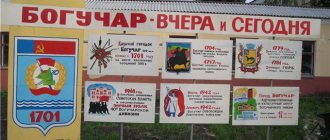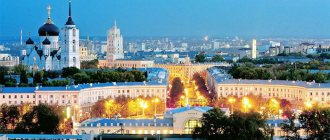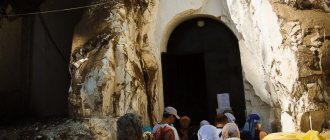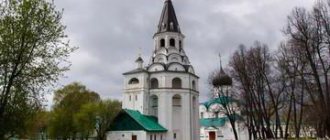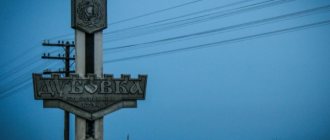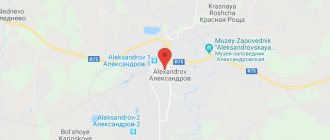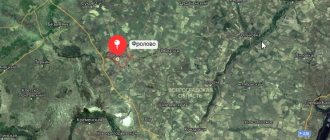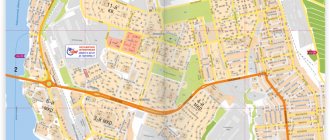| Borisoglebsk, Voronezh region |
Borisoglebsk
, a city in Russia, the administrative center of the Borisoglebsk urban district of the Voronezh region, the cathedral city of the Borisoglebsk diocese.
Located in the southeastern part of the Oka-Don Plain on the left bank of the Vorona River, five versts from the confluence with the Khoper River, 63 north of Uryupinsk, 240 km east of Voronezh. Railway station on the Moscow-Volgograd line. Population - 64,900 (2013) [1]. Historically, Borisoglebsk was also called in the 17th century. Daugavpils; in the end XVIII-early XIX centuries city of Yaroslavl province, now part of Tutaev
- On the map: Yandex.Map, Google map
Founded in 1646 as the Russian military fortress Pavlovskaya
.
The city of Pavlovsk
since 1698.
Around the same time, a shipyard was built here; during preparations for the capture of Azov, timber was harvested here for the construction of a coastal fleet. Borisoglebsk
after the construction in 1704 of a church in the name of the holy noble princes of Russia Boris and Gleb. In 1708 it was captured by participants in the Bulavinsky uprising. In the same year he was assigned to the Azov province.
Since 1719 it entered the Tambov province. Since 1725 - in the Voronezh province (since 1732 - in its Voronezh province). Since 1779 - a district city of the Tambov governorship, since 1796 - of the Tambov province. In 1806, Emperor Alexander I approved a plan for the regular rectangular development of Borisoglebsk.
After 1861 - the center of grain trade and a large industrial center in the east of the Black Earth Region; Twice a year, crowded fairs were held in the city. Trade contributed to the influx of banking capital. A decisive event for the development of the city was the construction of the Gryazi-Borisoglebsk-Tsaritsyn railway in 1869-1871, which led to the creation of new industrial enterprises in Borisoglebsk. At the end of the 19th century, there were 34 factories and factories, men's and women's gymnasiums, technical and railway schools, and 2 parish city schools.
After the revolution and the Civil War, Borisoglebsk continued to develop as an agro-industrial and cultural center. During this period, a number of industrial enterprises were put into operation, a teacher's institute, a technical school for agricultural mechanization, and a road technical school were opened. In 1923, the 2nd Military Pilot School was created, later the Higher Military Aviation School named after. Chkalova. After World War II, the city retained its importance as a major industrial and cultural center of the Prikhopery region.
Statistics
- 1856 - 8.1 thousand people, 4 churches, 867 houses, 56 shops
- 1897 - 22.3 thousand people
- 1913 - 28.2 thousand people
- 1931 - 44.4 thousand people
- 1959 - 54.4 thousand people
- 1976 - 69 thousand people
- 1989 - 72.3 thousand people
- 2003 - 69.4 thousand people
- 2010 - 65.7 thousand people
Story
Coat of arms (1781): “five bags laid one on top of the other, in a blue field, as a sign of abundance of wheat.”
The city was founded in 1698 (some sources indicate 1646), as the chronicler puts it, “to protect” from the raids of the restless Crimean, Azov and Nogai people, who “walked around as exiles and they fought all over the place, beat people and killed all sorts of people in the service and district.” Until 1704 it bore the name Pavlovsk (Novopavlovsk). Peter the Great, having proposed to conquer Azov, made Borisoglebsk a temporary depot for logging for the construction of a coastal fleet, which greatly contributed to attracting the population here and developing industry here.
In 1708, during the first division of Russia into 8 provinces, Borisoglebsk was assigned to the Azov province. In 1719, when the boundaries of the provinces were changed for the second time, Borisoglebsk entered the Tambov province, in 1732 it was transferred to the Voronezh province, and in 1779, when the Tambov governorship was formed, Borisoglebsk was made one of the 15 district cities of the governorship. The very favorable geographical position of the city, connected by waterway with the ports of the Azov and Black Seas (Vorona, Khoper, Don, Azov Sea), largely attracted to it the works of not only its own district, but also the districts of Kirsanovsky and Balashovsky and the entire southern half of the provinces and adjacent districts of the provinces of Saratov and Voronezh.
In 1869, “Brewery No. 4 of A. A. Nasonych” began operating. The plant produced dark and light varieties of beer, as well as fruit sparkling water. With the advent of Soviet power, the plant continued to operate in its original form. In the middle of the 20th century, the enterprise was modernized, new workshops were built and new lines were launched. Currently, the company continues to produce beer.
In Borisoglebsk at the beginning of the 20th century there was a very busy pier, called Khoperskaya due to its proximity to Khoper. Back in the 1870s, more than 52 thousand m³ of grain and flour were loaded at the local pier; in Borisoglebsk, on the meadow side of Khopr and Vorona, up to 2 thousand barges were built annually, sending goods to Rostov and Taganrog; Every year up to 10 thousand barge haulers visited here. By constructing the Gryaze-Tsaritsyn road, Borisoglebsk connected with Tsaritsyn and, consequently, with the Volga region, on the one hand, and with the ports of the Baltic Sea, on the other, and quickly became one of the busiest grain trading points of the black earth region, through which they were sent to St. Petersburg and Moscow bread, timber, kerosene, fish, caviar, watermelons, as well as salt from the lakes of the Astrakhan province, which was supplied to the entire railway area.
In 1890, on the Gryazi - Borisoglebsk section (199 km), the revenue for the transportation of goods, etc. - 3,418,925 rubles, or - 17,181 rubles / km. According to information from 1885, Borisoglebsk had a population of 13,007 inhabitants (6,325 males and 6,682 females), almost exclusively Orthodox. In Borisoglebsk at the beginning of the 20th century there were women's (4 classes) and men's (6 classes) gymnasiums, a technical railway school, two parish city schools, etc. The Kazan fair (July 6) stood out from the fairs, which lasted 3 days and had an important (local) economic significance.
During the Civil War, it was in the combat zone between the Workers 'and Peasants' Red Army, on the one hand, and the Volunteer and Don Armies, on the other, and repeatedly changed hands. Borisoglebsky district was engulfed by the Tambov uprising.
In December 1922, the 2nd Military Pilot School of the Red Air Fleet was created in Borisoglebsk, training pilots for the Air Force, which later became the Borisoglebsk Higher Military Aviation Order of Lenin Red Banner Pilot School named after V.P. Chkalov, since May 2001 - Borisoglebsk Aviation Training Center (branch) of the Krasnodar Higher Military Aviation School of Pilots (now the Kachin Military School).
In 1940, on the basis of the pedagogical school, a teacher's institute was founded, consisting of two departments - physics and mathematics and philology. He gave graduates an incomplete higher education. In September 1952, the Teachers' Institute was reorganized into a Pedagogical Institute, designed to train specialists with higher education for secondary schools.
Religion
In the 1920-1930s, there was the Boris and Gleb Vicariate of the Voronezh Renovation Diocese.
Since 2003, Borisoglebsk has been the second cathedral city of the Voronezh diocese.
On December 26, 2013 it became the cathedral city of the newly established Borisoglebsk diocese.
The Saints
- St. Nikandr Borisoglebsky (local reader [2]).
Monastery
- Alexander Nevsky Khrennikov Monastery (closed in the 1920s)
Temples
- Boris and Gleb
- Joy to all who mourn, icons of the Mother of God
- Znamenskaya Icon of the Mother of God
- Kazan Icon of the Mother of God
- Nicholas the Wonderworker
- Transfiguration of the Lord, Cathedral (inactive) [3]
- Presentation of the Lord (invalid)
Geographical location
The city is located on the left bank of the Vorona River, near its confluence with Khopyor, 204 km from Voronezh. It is customary to distinguish the Northern and South-Eastern microdistricts within the city. Aerodromnaya Street is also actually a microdistrict where, in Soviet times, apartments were provided to military families and aircraft repair plant workers.
Historically, Borisoglebsk has unofficially identified the following districts: Vodostroy, Vorovo, Kirpzavod, Lakhmutovka, Makurevka, Soldatsky, Stanichny, Cheryomushki, Severny, Yuzhny, Aerodromnaya, some of which were previously settlements or villages, later included in the city.
Borisoglebsk
The history of Borisoglebsk begins in the middle of the 17th century. Construction of the city began in 1654. However, some scientists also name other years: 1646 and 1698. Borisoglebsk was located on the southeastern border of the state. It was supposed to become a fortified point and protect the state border in the southeast. The foundation of the city was planned back in the 30s of the 17th century. A letter from the late 30s from Tsar Mikhail Fedorovich states that residents of the southeast of the country are constantly disturbed by “Tatar and Nogai people.” Attacking the local population, the “people” ravaged villages and killed residents. The survivors were forced to leave their homes. And this, in turn, could lead to the fact that the southwestern border would remain unprotected and vulnerable. In 1644, the Crimean prince Kalga raided several villages. Some of the inhabitants were exterminated. Many fell into slavery. The villages were completely destroyed. It was this event that made the king seriously think about how to protect his subjects.
Borisoglebsk was conceived as a fortress city that could repel the attack of any enemy. The location of the city was planned in such a way that it was closed from the west and south by the Vorona and Khoper rivers. The first inhabitants were people who professionally wielded weapons: archers, boyar children, Cossacks, pishchalniks. They lived in a wooden fortress surrounded by a moat. Service people gradually began to be allocated plots of land around the fortress. Each such plot of land subsequently became a settlement.
The new fortress was originally called Pavlovsk (according to another version - Novopavlovsk). In 1704, a church was built in the city in honor of Saints Boris and Gleb. In the same year, the city changed its name to Borisoglebsk.
In the era of Peter the Great, Borisoglebsk became famous thanks to the Tellerman Forest. Peter I, as you know, studied shipbuilding in Holland. Returning home, he decided to build a fleet. But not just any forest was suitable for these purposes. The necessary wood was found near Borisoglebsk. Shipbuilding attracted a huge number of people to the city, which contributed to the growth of the population and the expansion of the city's borders. In addition to shipbuilders, other workers also moved to the city. The Tsar was thoroughly preparing for the Azov campaign; he needed experienced specialists.
In 1708, after another reform of Peter the Great, the country was divided into provinces. Borisoglebsk was assigned to the Azov province. A few years later, in 1713, the city experienced the last invasion of Tatar troops. In 1719, the borders of the Azov province were changed. From now on, Borisoglebsk began to belong to the Tambov province, and from 1732 to the Voronezh province. In 1779, Borisoglebsk received the status of a city of governorship.
After the death of Peter I, Borisoglebsk gradually lost its significance as a military fortress. The main occupations of the townspeople are trade and crafts. The city’s connection with the ports of the Black and Azov Seas made it possible to send goods abroad, as well as bring imports into the country. The successful location of the city contributed to successful trade. Many trade routes of the Russian state intersected here.
A new era in the development of the city began under Alexander I. By that time, Borisoglebsk had already established itself as a trading city. The Tsar created a new development plan for Borisoglebsk. The development of the city began with the development of a huge plot of land on the side of the Vorona River. The rectangular building, unusual for those years, has been preserved to this day.
In the middle of the 19th century, the city became a center of grain trade. The presence of a navigable river near the city made it possible to export grain abroad or transport it within the country. By 1860, even before the abolition of serfdom, more than thirty enterprises operated in Borisoglebsk (wax, brick, lard, soap, etc.). In addition, there were 2 schools, 4 churches and a hospital.
The abolition of serfdom in 1861 contributed to the improvement of trade relations between Borisoglebsk and other cities of the Russian Empire. A huge number of trading companies appeared that bought grain in villages and transported it to Borisoglebsk. Twice a year, fairs were held in the city, which were attended by residents of the cities and villages closest to Borisoglebsk. The Kazan Fair attracted the largest number of visitors. A famous French purchasing office even appeared in the city. Tamazini and Veseri, a Greek company, also turned its attention to the city and also opened its representative offices here.
But the most successful economic development awaited the city after the construction of the Gryazi – Borisoglebsk – Tsaritsyn railway. The road was built over two years, from 1869 to 1871. This road connected the city with several ports on the Baltic Sea, as well as with a huge number of industrial centers throughout the Russian Empire. Relatively small Borisoglebsk needed additional workers as new enterprises appeared in the city. Goods produced in Borisoglebsk, as before, are exported, only now in even larger quantities.
By the end of the 19th century, about forty plants and factories operated in the city. A few kilometers from Borisoglebsk there were large estates where pedigree cattle, poultry, and fine-wool sheep were raised. Horse breeding was considered the most developed. In the vicinity of the city there were more than twenty stud farms. Thanks to the huge number of enterprises in Borisoglebsk, it was possible to process agricultural products directly in the city, without sending them anywhere. The number of city residents by that time had increased several times. The rapid development of the economy contributed to the increase in capital. Several branches of the largest banks of those days appeared in Borisoglebsk. In addition, several more representative offices of foreign companies have opened in the city.
In 1917, during the October Revolution, the city found itself in the midst of a civil war. Several times Borisoglebsk passed from the Red Army to the White Guard and back. The revolutionary year of 1917 was also marked for Borisoglebsk by the fact that this year a pedagogical society appeared in the city, the members of which were teachers of secondary and higher educational institutions. The teachers set themselves the goal of improving the quality of public education.
From 1917 to 1941, residents of Borisoglebsk revived the industry of their hometown. Old enterprises were reconstructed and new enterprises were opened. Colossal work was also carried out to eliminate illiteracy and raise the cultural level of the population.
During the Great Patriotic War, Borisoglebsk became a front-line city. Military units are being formed here and military hospitals are opening. It was to Borisoglebsk that the most important government institutions in Voronezh were evacuated.
In the post-war years, Borisoglebsk was actively and rapidly restored. The most productive were 3 decades: the 60s, 70s and 80s. Economic development stalled during the years of perestroika. But, starting from the early 2000s, the economy of Borisoglebsk is gradually returning to the “pre-perestroika” level. Today, 2 dozen enterprises operate in the city, the largest of which is Borkhimmash OJSC.
Education
- Borisoglebsk branch of Voronezh State University (formerly Borisoglebsk State Pedagogical Institute).
- III Faculty of the Krasnodar Higher Military Aviation School of Pilots
- 4 branches of Moscow and Voronezh universities [ which ones?
] - Borisoglebsk College of Industrial and Information Technologies (formerly Borisoglebsk College of Informatics and Computer Engineering, Borisoglebsk Industrial College, Vocational School No. 34).
- Borisoglebsk Road College
- Borisoglebsk Agricultural College
- Borisoglebsk Medical College
- Borisoglebsk Music School
- Borisoglebsk Technological and Economic College
Economy
- Borisoglebsk Machine-Building Plant LLC (BMZ LLC)
- JSC "Borisoglebsk knitwear"
- JSC "BKMZ" (Borisoglebsk Boiler-Mechanical Plant (Borisoglebsk Chemical Engineering Plant of the Order of the Red Banner of Labor)
- BorKotloMash LLC
- LLC "ZNIGO" oil and gas equipment plant
- PJSC "Irbis" (Plant of boiler equipment and heating systems BKMZ)
- OJSC "BKMZlit" (Iron foundry BKMZ)
- JSC "BPSZ" (Instrument-Making
- CJSC "Borisoglebsk Communication Systems"
- JSC "Patrony"
- OJSC "711 ARZ" (Borisoglebsk Aircraft Repair Plant)
- Brickworks
- Brewery
- Bakery plant
- Bread
- Group
- JSC "Mechanika"
- LLC "Plant of Foam Concrete Products"
- Borisoglebsky Oil Extraction Plant LLC
- Khimmash-Spets-Komplekt LLC
Mass media
Internet providers
- Internet provider Rostelecom is a telecom operator in Borisoglebsk. Providing Internet access and interactive television services to individuals and legal entities.
- "Inforum" - an Internet provider provides the population with high-speed Internet access, both in apartment buildings and in private ones, using GPON technology.
- Vipline is an interregional telecommunications operator that provides a full package of telecommunications services based on advanced technologies for wireless broadband Internet access.
- "House of MTS" - the home provider of "MTS", provides the population with high-speed Internet access, as well as cable television services.
Connection
Fixed telephone and mobile Internet services in Borisoglebsk are provided by the following operators:
- "MTS"
- "Beeline"
- "Megaphone"
- "Tele 2"
- Rostelecom
- "Yota"
- "Tinkoff"
All of the listed operators operate in the modern 4G-LTE standard, as well as 3G-UMTS/HSDPA+, 2G-GSM/EDGE standards.
Broadcasting
In total, there are 16 radio stations in the city broadcasting in the FM range and 2 VHF in the silent range.
- 68.24 VHF Radio Mayak (Silent)
- 70.82 VHF Radio Russia / State Television and Radio Broadcasting Company Voronezh (Silent)
- 88.1 MHz Radio ENERGY
- 91.4 MHz Radio Record
- 91.9 MHz Radio Chanson
- 99.0 MHz DFM
- 99.9 MHz Elite FM
- 100.4 MHz Our radio
- 100.8 MHz Retro FM
- 101.7 MHz Autoradio
- 103.0 MHz Road Radio
- 103.6 MHz Europe Plus
- 104.1 MHz Radio Russia / State Television and Radio Broadcasting Company Voronezh
- 104.7 MHz Radio Dacha
- 105.8 MHz Radio Melody
- 106.2 MHz Russian Radio
- 106.7 MHz Radio Vanya
- 107.5 MHz Humor FM
HISTORY OF THE CITY OF BORISOGLEBSK, VORONEZH REGION AT THE END OF THE 17TH CENTURY – ½ OF THE 19TH CENTURY.
2.1 Administrative structure and economic development of the city of Borisoglebsk
Novo-Pavlovsk as the city of Borisoglebsk began to be named in 1704 after the church consecrated in honor of princes Boris and Gleb. At the beginning of the 18th century, the city of Borisoglebsk had a territory subordinate to it with settlements assigned to the city and had long been associated with it primarily economically. There were seven such settlements at that time: Chegardayskaya, Karayskaya, Boganinskaya, Tantsyreevskaya, Karachanskaya, Gribanovskaya settlements; settlement Russkaya Polyana.
The distance from the centers and proximity to the lands of the Don Army forced our city to perform guard functions for a long time. Almost all the interests of its population were subordinated to this, which left a peculiar imprint on the entire internal life of the city.
The administrative part of the city in the 18th century was preserved within the territory previously occupied by the fortress. There were wooden buildings here that housed: the mayor's office, the lower zemstvo and district court, the prison hut, the treasury, the cash storeroom, and the city hall.
Near the fortress there were settlements of service people: soldier's, stanitsa, clerk's and love spell. Civil officials mainly lived in the clerk's settlement, "for the word 'clerk' meant the class of employees."
In the love settlement there lived service people who served the entrance gate to the fortress.
According to the legislative act on changing the administrative-territorial division of the state, Borisoglebsk in 1779 became part of the Tambov governorship as a county town.
In appearance it was quite picturesque, but at the same time cramped due to the crowding of houses on crooked and narrow streets and free due to the abundance of vacant lots, vegetable gardens and orchards. The city had no amenities.
The construction of the city until the end of the 18th century was mainly wooden. Wooden fortress towers and churches were the dominant features of the development, fixing its main functional components in the urban environment: the Cathedral of Boris and Gleb was located in the fortress, the Transfiguration Church - on Torgovaya Square, the Kazan Church - in Soldatskaya Sloboda. During the same period, the first large stone building was built - the Assumption Cathedral. The wooden buildings under the thatched roof constantly caught fire. To reduce fire danger, the City Hall prohibited burning stoves in houses in the summer. Fighting natural fires and providing basic amenities have become an obvious necessity.
Suitable premises were needed to accommodate the newly created county institutions. Public offices had to be located in a building with an impressive facade in order to assert the prestige of power in the eyes of the population.
On October 19, 1806, the regular plan of Borisoglebsk was approved, which was preceded by long and painstaking work by local surveyors. The archives preserve many working versions of the city plan, equipped with detailed descriptions of existing and newly designed public and industrial buildings. Their construction was carried out strictly in accordance with the master plan. Thus, in the quarter allocated for “state buildings”, until the middle of the 19th century there were buildings of a prison, city council, government offices, and a hospital. Near the river and its floodplain there were wax mills, soap factories, beer factories, wineries, tanneries, wool mills and water mills. The tallow factories and windmills were located outside the city ramparts. The forges were concentrated in the northern ravine. The center of the active life of the city became a shopping area with neat rows of shops, wine and salt shops, and drinking houses.
At the head of the city was a governor. The first governor was Nikita Scriabin. He had all the power in the fortress. He supervised economic life, construction, regulated trade, exercised military leadership of the fortress, distributed cash salaries and grain allowances to the soldiers. The voivode also entirely owned the judicial power. “He did not allow obscene speech about the sovereign, and sent the perpetrators to prison until the case was examined.” The voivode also ensured that there was no unauthorized production of wine or the bringing of forbidden goods (gunpowder, lead, weapons) by the Cossacks to Khoper. He ensured that taxes were received correctly. He examined cases of robbery, forgery, pimping, beatings, counterfeiting coins and imposed punishments. The governor’s duty was to announce the tsar’s new decrees to the inhabitants of the fortress. Clerks helped the governor. Clerks formed the basis of the administrative apparatus of the voivodeship department. For some, this profession has become hereditary.
The duration of voivodeship service was 2-3 years. Then this period was extended. In the 19th century, the duties of the head of the city began to be performed by the mayor.
Important functions of a police nature were performed by “circumventive heads.” They were entrusted with overseeing fire safety and monitoring the implementation of public order. They were responsible for ensuring that there were no fights, drunkenness, tobacco use, illegal games, etc. anywhere.
Due to its location on a large waterway, the presence of rich fertile lands, forests, steppes and rich pastures in the conditions of widespread small-scale production in Russia, the city developed as a center for trade in grain, livestock, and leather. Trades developed: blacksmithing, cooperage, tanning. Trade in bread products had a serious influence on the development of the city.
Despite the fact that Borisoglebsk was far from the theater of military operations, the French invasion caused a great patriotic upsurge among the city's residents. In the summer of 1812, lively city gatherings took place in Borisoglebsk. Issues about donations, recruiting, and enrolling in the militia were resolved. A meeting of all city classes took place in the City Duma. After the mayor read out the “highest” decree “On the gathering of new forces within the state” and the call for “zealous love for the fatherland,” voluntary donations took place. Borisoglebsk residents took part in the battles with the French as part of the Tambov militia.
On January 22, 1814, Alexander I issued a decree on the dissolution of the militia, which had endured “extraordinary labors and repeatedly shown courage and bravery in dealings with the enemy.”
In the 40s, the city of Borisoglebsk occupied an area of 2,576 acres. The streets were not yet paved; there were 2 squares. The central part of the city was illuminated at night by seven lanterns. The growth in city revenues allowed the city authorities to begin developing the retail space in earnest. "K1835 - 1841 A project was developed showing a place for a church, shop buildings, a guest courtyard, and a drinking house. By 1845, the Gostiny Dvor was built.”
By 1847, there were about 20 stone private houses in Borisoglebsk. In the 50s of the 19th century, the trading area was decorated with several two-story shops. By this time, the growth in the economic well-being of Borisoglebsk residents was reflected in the massive construction of 1-2-story brick houses in the city center.
2.2 Social development of the city of Borisoglebsk
In the first years of the city's existence, its residents experienced great difficulties. So, in 1705, there was a crop failure in the Tambov region, including the Borisoglebsky lands. That summer, according to the Tambov chronicler, locusts attacked and destroyed the grain crops. As a result, dozens of Boris and Gleb families were forced to leave their homes. 50 families left the soldiers' settlement of Borisoglebsk alone.
In the first third of the 18th century, service people mainly lived on the lands of Boris and Gleb. They collected firewood and timber for the Azov flotilla. Peter I carefully monitored the careful handling of ship timber. Decrees were issued “On the non-cutting of forests thicker than a span for firewood” and “On protected forests”, according to which contractors of various works and residents were prohibited from cutting down forest suitable for shipbuilding.
Peter's reforms in Russia, despite their progressiveness, were carried out by force, often cruel methods. Heavy responsibilities for the costs of shipbuilding and the creation of a regular army fell on the shoulders of the peasants. As a sign of protest, escapes to the Don under the protection of free Cossack customs became more frequent. Concerned about this, in the fall of 1707 Peter I sent a punitive expedition to the Don under the leadership of Prince Yu.N. Dolgorukova. But here an uprising broke out, led by Kondraty Bulavin. The rebels destroyed Dolgoruky's detachment, killed him and began to destroy the boyars and landowners in the lands adjacent to the Don.
In April 1708, the Bulavinians captured Borisoglebsk. From the story of the Borisogleb clerks Vasily Protopopov, Ivan Tomilin, Prokofy Polshin, Konstantin Zhiltsov and the peasant Filimonov, it became known that “in the sixth week of Lent, priest Alexei came from the rebel Bulavin to Borisoglebsk in the Khoper town with many thieves and slandered the inhabitants of Borisogleb, all the convicts were dismissed, and all the sovereign's gunpowder was carried out of the city. Clerk Katasonov stopped the villains, but he was beaten many times, and he went into the city, sounded the alarm, and at that alarm, no one came to him from the city residents, and they did not fight him off...” The Borisoglebsk residents supported Bulavin, swore allegiance to him and even went on a campaign against the tsarist troops, in which they were defeated.
The uprising led by Bulavin was brutally suppressed. By order of Peter I, a number of Cossack towns involved in the uprising were destroyed. However, Borisoglebsk survived.
In 1719, a “terrible pestilence” broke out in Borisoglebsk - a plague epidemic that wiped out entire families and it seemed that there was no escape from it. Peter I took the most decisive measures against the spread of the plague. Quarantine outposts in the Borisoglebsk area had large guards. It was ordered not to let anyone through from the “destroyed places.” In case of resistance, the order was to shoot. And those who broke through the outpost were to be hanged immediately without trial, no matter who he was.” There were gallows right next to the outposts. The homes of those who died from the disease were burned along with all their property. As a result of the measures taken, the plague in our area began to decline, which Captain Gorokhov reported to Peter I in 1720.
After the death of Peter I, shipbuilding continued in Borisoglebsk for some time. Small ships were built, timber was rafted to Azov. However, the city gradually lost its former military significance.
In the first third of the 18th century. Our region was very sparsely populated. Moreover, there was even a large outflow of population, as shown by the 1721 census. So, in the Borisoglebsk district there were 7 settlements, only 545 people living in them: 103 people who worked for hire, 24 people who were poor, etc. (total 706 people).
Since the 30s of the 18th century, a new stage in the settlement of our region began. New settlements appeared. They were usually named after the names of the first settlers, rivers, church buildings and holidays, and location. The free expanses of our region attracted new settlers, especially since in the 30s in the vicinity of Borisoglebsk only 3.8% of the land was inhabited. People's (not landowner) colonization was the main thing for our area at that time.
At the same time, it cannot be denied that our rich black soils gradually began to go to the most eminent families of the royal court.
So, L.K. Naryshkin, a relative of the king, received land with an area of 73,902 dessiatines within the boundaries of Vorona and Khopr, i.e. about 900 hectares.
For active participation in the suppression of the Bulavin uprising, some lands of our region (Gribanovka, Malaya Gribanovka, up to the Savala River) were donated by the Tsar to Prince A.D. Menshikov.
The monasteries of Savvo-Storozhevsky, Trinity, and Mammoth Monasteries did not lag behind the large patrimonial lands.
The second half of the 18th century was marked by a significant increase in noble land ownership. But especially generous grants of lands and peasants to the nobility began under Catherine II, who spared nothing for her associates and favorites. The freedom received by the nobles under the Manifesto of 1762 (it freed them from compulsory service) allowed a significant part of them to settle on the land and take up farming. Serfdom intensified. Agriculture in the county was almost entirely in the hands of the landowners. On the vast steppe expanses of the district lie the estates of Prince Volkonsky, Count Kushelev - Bezborodko, landowners Kondoidi, Rymarev, Arshenevsky and other serf owners who were attracted here by the fertility of the lands. With the most primitive methods of farming, the yield here was much higher than in other counties of the Tambov region.
The exceptional fertility of the soil is even reflected in the coat of arms of the city of Borisoglebsk. It showed five tied bags of bread on a blue field. Subsequently, it was supplemented with the provincial coat of arms of Tambov and began to look like a shield divided into two parts. On the upper part there was a picture of a golden beehive placed on green ground and three golden bees, and on the lower part there were still five bags of bread.
In the economic note to the atlas of the Borisoglebsky district of the late 18th century, nobles in the amount of 32 people were presented for the first time among the city’s residents. The landowner peasants endured the tyranny of the landowners - serf-owners - that existed at that time.
Researcher of the Tambov region I.I. Dubasov O.
By the middle of the 19th century, the economy in Borisoglebsk was intensively developing.
“The first factories appeared: a brewery, two lard-heating factories, eight distilleries, two soap-making factories. Two squares stood out: the main administrative one - in - on the outskirts.” Traditionally, daily trade continued in the main square. By this time there were 19 trading shops in the city. A little later, one cathedral stone church, four wooden parish churches, five philistine stone buildings and 300 wooden houses were built. Stone buildings are located in the city center: the city council, town hall, treasury, government offices.
This contributed to the growth of the city and its population. In 1840, Borisoglebsk had 5,379 inhabitants, of which 2,755 were men and 2,624 women. The population included: 37 clergy, 105 nobles and officials, 6 honorary citizens, 3 merchants of the second guild, 3 merchants of the third guild, 1969, burghers and townspeople - 2657.
The Khoper and Vorona rivers, connecting the Boris and Gleb lands with the lower Don, played an important role in the economy of the region. Since 1840, rafting of barges with grain and timber began to develop in Borisoglebsk. From 1847 to 1853, 10 barges with cargo, the cost of which reached 400 thousand silver rubles, left Borisoglebsk; every year trade and shipping grew in size. Merchants from Balashov, Nakhichevan, and Taganrog began to come to the city. Balashov merchants preferred to load barges in Borisoglebsk. Merchants from Taganrog and Rostov bought lard, wool, timber, grain and sent them on barges to Rostov-on-Don. The movement of ships along the rivers, in addition to the power of the river, was ensured by barge haulers. During their season, up to a thousand people gathered in Borisoglebsk.
The purchase and sale of livestock played an important role in the trade balance. Borisoglebsk traders annually purchased up to 10 thousand heads of large and up to 15 thousand heads of small livestock from the lands of the Don Army, Yekaterinoslavl, Kharkov, Saratov. Most of the cattle were processed on site. Lard was rendered from it, which was exported along the winter route to Moscow and St. Petersburg, and from there abroad. The meat was salted and sent to neighboring cities or sold by barge haulers. Large and small leathers were sold locally, as well as in Lebedyan and Uryupino. Up to 2,000 head of livestock per year were delivered to Moscow live. Trade in livestock and lard was in the hands of prasol merchants, while trade in leather was carried out by the townspeople. By water alone, through Rostov and Taganrog, Boris and Gleb merchants began to annually send abroad up to 7 million pounds of grain and flour, a lot of leather, lard, vegetable oil, poultry and eggs.
Water transport was serviced by about 10 thousand barge haulers. But the water system carried cargo only in the summer. In winter, when the rivers froze, traffic on the main roads came to life. An endless line of carts and herds of cattle stretched, and merchants, landowners, and officials rode on carriages. Huge spaces were covered over weeks and months. For example, the herds were on their way to Moscow for more than a month.
In 1860, the city had 31 enterprises (6 wool-washing, 2 soap-making, 10 lard-making, 4 wax-making, 8 brick-making, 1 iron-smelting).
Changes have also occurred in the socio-cultural appearance of the city. In 1860, there were 9,356 people living (of which 2,599 were merchants and 5,682 tradesmen). On eight streets and two squares there were 737 houses, 79 shops, 4 churches, there were two schools - a district school (opened in 1836) and a rural parish school, and 1 hospital. Since 1837, city residents began to regularly receive the newspaper “Tambov Provincial Gazette”, in the unofficial section of which articles by the Borisogleb landowner, corresponding member of the Free Economic Kh. Kozlov, were published.
The rapid growth of capitalism in Russia, which began in the second half of the 19th century, urgently required the construction of railways. The developing economy of Borisoglebsk also required this.
During the 18th – first half of the 19th centuries, changes took place in all spheres of life in our city. Gradually, as Russia's borders moved south, Borisoglebsk lost its military significance and by the middle of the 18th century it turned into a trade and craft city - a significant point for the purchase and sale of grain, livestock, timber, and agricultural products. The waterway connected it with the ports of the Azov and Black Seas. Trade fairs were held in Borisoglebsk twice a year - in July and October. Trade brought to life a variety of industries - wool washing, soap making, lard making, wax cutting, brick making, iron smelting. The economic development of the city in the mid-nineteenth century led to an increase in population.
Notable residents
The names of many famous people are associated with Borisoglebsk. The following were born in Borisoglebsk:
- Ablesimov Alexander Alexandrovich - Honored Doctor of the RSFSR, first head of the Borisoglebsk maternity hospital. Founder of Borisoglebsk Medical School.
- Anosov, Nikolai Pavlovich - Soviet conductor, teacher, historian and conducting theorist.
- Buchbinder Joseph Lvovich is a Russian theoretical physicist, Honored Scientist of the Russian Federation.
- Ilchenko Viktor Leonidovich - pop artist, Honored Artist of the RSFSR.
- Kin (Surovikin) Viktor Pavlovich - writer.
- Alexander Fedorovich Kots - Doctor of Biological Sciences, professor, founder of the Darwin Museum.
- Krivenko Sergei Nikolaevich is a Russian publicist of the populist movement.
- Kuzovkov, Ivan Aleksandrovich - Colonel General. Hero of the Soviet Union.
- Kuprin Alexander Vasilievich - landscape artist.
- Menshikov Mikhail Alekseevich - Soviet diplomat.
- Nedelin Mitrofan Ivanovich - chief marshal of artillery.
- Rybnikov Nikolai Nikolaevich - Soviet actor, People's Artist of the RSFSR.
- Sawyer, Moses - American painter.
- Sawyer, Raphael - American painter.
- Tretyakov Yuri Fedorovich - children's writer.
- Sholokhov Pyotr Ivanovich - painter.
- Shchenyaev Vladimir Egorovich - master of sports of the USSR
Borisoglebsk is a historical city in Russia
Administration of the Borisoglebsk urban district 397160 Voronezh region, Borisoglebsk, st. Svobody 207 reception: (47354) 6-05-01, (47354) 6-22-67 website
Located in the northeast of the Voronezh region at a distance of 204 kilometers from Voronezh and being the administrative center of the Borisoglebsk urban district, the city of Borisoglebsk is among 7 cities of the Voronezh region (Bobrov, Boguchar, Borisoglebsk, Voronezh, Novokhopersk, Ostrogozhsk, Pavlovsk) was included in 1990 a list of historical settlements in Russia, approved by resolutions of the board of the Ministry of Culture of the RSFSR, the board of the State Construction Committee of the RSFSR and the presidium of the Central Council of VOOPIiK.
View of Boris and Gleb Cathedral (1900)
However, in July 2010, by a joint order of the Ministry of Culture of the Russian Federation and the Ministry of Regional Development of the Russian Federation, that list was reduced by more than 11 times - from 478 to 41. Moreover, officials who manage the culture and development of Russian regions, according to their own concepts, from the federal list along with all 7 Voronezh historical cities erased such historically significant settlements as Moscow, Veliky Novgorod, Pskov, Uglich, Pereslavl-Zalessky. At the same time, as you understand, all these cities have not become any less significant and continue to remain large and small historical centers of Russia in the eyes of Russians. Therefore, leaving behind the officials the right to decide on paper the issues of whether a particular settlement belongs to the historical values of Russia, let’s turn to real life, in which Borisoglebsk was, is and will remain a historical city of our region and our country.
Borisoglebsk from a bird's eye view
Borisoglebsk was founded in 1698 on a plateau near the Vorona River, which flows nearby into the Khoper River, as a wooden fortress on the outskirts of the Russian state. According to the chronicler, this was done “to protect” from the raids of the restless Crimean, Azov and Nogai people, who “walked around as exiles and they fought all over the place, beat people and killed all sorts of servicemen and district people.”
Originally called Pavlovsk, from 1704 the fortress began to be called Borisoglebsk - after the name of the cathedral church, consecrated in honor of princes Boris and Gleb, the sons of Vladimir the Holy, killed in 1015 and canonized as Orthodox saints.
Monument to Boris and Gleb on Starosobornaya Square
At the end of the 17th century, in connection with Peter the Great’s preparation for a campaign against the Turkish fortress of Azov, shipyards were founded on the Khopra and Voron rivers. In this regard, Borisoglebsk acquired special significance, becoming a temporary depot for the procurement of ship timber, the felling of which took place in the vicinity of the city in the so-called Telerman forest.
Simultaneously with logging, coastal ships for the Azov flotilla, as well as several fairly large warships, were built on the stocks of the Borisoglebsk shipyards, and among them were the “Good Beginning”, “Unia” and “Fearlessness”.
Construction of warships (engraving from the time of Peter the Great)
By the middle of the 18th century, Borisoglebsk had turned into a trading and craft city - one of the largest points in Russia for the purchase and sale of grain, livestock, agricultural products and timber. The city annually hosted 3 large fairs: Kazan (summer and autumn) and Three Saints (January). And the city’s coat of arms, approved in 1781, was the result of recognition of its administrative and economic role in state affairs: five bags of bread placed one on top of the other denoted the main wealth of the region.
From the 18th to the 19th centuries, large farms of the Volkonsky, Gagarin, Kondoidi landowners, and the Anosov merchants arose on the lands of Borisoglebsky district.
Borisoglebsk at the end of the 19th century
A special place in the history of the city is occupied by the activities of the Borisoglebsk landowner Prince S. M. Volkonsky, a prominent theater figure and grandson of the Decembrist S. G. Volkonsky.
Volkonsky House in Borisoglebsk
In the spring of 1918, S. G. Volkonsky organized the first exhibition in Russia dedicated to the Decembrists in Borisoglebsk.
Monument to M. Gorky on the station square of Borisoglebsk
One of the pages in the life of the writer Maxim Gorky is connected with Borisoglebsk, who in 1889 - 1890 worked as an artel worker at a commodity checkout and as a warehouse guard at a warehouse at the railway station. He subsequently described this in the story “The Watchman,” first published in the fifth issue of the Krasnaya Nov magazine in 1923.
Monument to Fighters for Soviet Power
During the Civil War, Borisoglebsk was located in the combat zone between the Workers 'and Peasants' Red Army, on the one hand, and the Volunteer and Don Armies, on the other, and repeatedly changed hands. And later Borisoglebsky district was engulfed by the Tambov uprising.
V. Chkalov (right) with cadets of the Borisoglebsk military pilot school (1923)
The 2nd Military School of Red Air Fleet Pilots, established in the city in 1923, brought all-Union fame and glory to Borisoglebsk. From its walls came such legendary pilots as V.P. Chkalov, V.K. Kokkinaki, N.P. Kamanin, A.B. Yumashev and V.V. Talalikhin. On the basis of the famous pilot school, the Borisoglebsk Higher Military Aviation Order of Lenin Red Banner Pilot School was organized. V.P. Chkalov, which since May 2001 was transformed into the Borisoglebsk Aviation Training Center (branch) of the Krasnodar Higher Military Aviation School of Pilots (now Kachinsky Military School).
Memorial in honor of graduates of the Borisoglebsk Military Aviation School named after. V. Chkalova
A memorial opened near the school in 2015 is dedicated to its most famous graduates. Its central figure is a bust of Chkalov, on both sides of which there are 12 busts of Heroes of the Soviet Union, who were awarded this award twice. The names of another 263 Heroes of the Soviet Union and Russia, engraved on a granite memorial slab, remind us of the exploits of the Chkalovites.
One of the brands of Borisoglebsk is the Borisoglebsk Municipal Drama Theater named after N. G. Chernyshevsky. Having started its first theater season in 1937, it is deservedly considered one of the best theaters in small towns in Russia. The repertoire includes performances based on works by Ostrovsky, Williams, Chekhov, Lorca, Durrenmatt, Olshansky and other authors. The theater building itself is also valuable - in the past the people's house of the merchant Mokhov, and now a monument of history and architecture of the early 20th century.
In total, there are 113 cultural and architectural monuments in the city. In this sense, Borisoglebsk is a kind of open-air museum, the basis of which is the architectural complex of the central part of the city with the unique buildings of the 19th century.
Unveiling of the monument to Boris and Gleb on Starosobornaya Square
The city-forming center of Borisoglebsk is Starosobornaya Square, which begins at the walls of the oldest church in the city in the name of the Holy Princes Boris and Gleb. Originally built in wood in 1703, its stone building was erected on the site of a wooden church in 1792. And in 2021, a monument to Saints Boris and Gleb and a foundation stone in honor of the city of Borisoglebsk, whose name combines the names of both saints, were erected on the square in front of the temple.
Foundation stone on Starosobornaya Square
Among the architectural and historical monuments, the Borisoglebsky railway station stands out - built in 1871, it is a beautiful building with elements of the Renaissance, Russian style and classicism. The famous Russian traveler Semenov-Tyan-Shansky, who had seen a lot in his time, considered it one of the best stations on the entire South-Eastern Railway.
Railway station in Borisoglebsk
A special place in the architecture of Borisoglebsk is occupied by wooden residential buildings that have preserved ancient elements of decorative decoration of buildings from the late 19th - early 20th centuries.
Opened at the beginning of the 19th century as a school museum and in 1929 receiving state status, the Borisoglebsk Historical and Art Museum is one of the oldest museums in the Voronezh region and at the same time is considered one of the largest in the region in terms of the number of exhibits: more than 70 thousand items are stored in its funds.
Borisoglebsk Museum of Local Lore
More than a thousand paintings are kept in the funds and participate in the permanent exhibition of the Borisoglebsk Art Gallery, which bears the name of the famous Soviet artist P. I. Sholokhov, who was born and lived for a long time in Borisoglebsk. Along with the master’s works, the eight exhibition halls of the art gallery display works by other artists: A.P. Ryabushkin, N.M. Chernyshev, A.V. Kuprin, I.I. Mashkov and Yu.I. Rogozin.
Borisoglebsk Art Gallery
Borisoglebsk went down in the history of the USSR as the birthplace of the Hero of the Soviet Union, the First Commander-in-Chief of the USSR Missile Forces, Chief Marshal of Artillery M. I. Nedelin.
The house in Borisoglebsk where M. Nedelin was born and lived
This is recalled by a memorial plaque on the house where the future marshal was born and lived, as well as his bust installed in the city center.
Among the monuments that can be considered landmarks and at the same time business cards of Borisoglebsk, there is a sculpture installed in 2021 in honor of another legendary Borisoglebsk resident - the favorite film actor of the Soviet era, People's Artist of the RSFSR N. N. Rybnikov.
Monument to People's Artist of the RSFSR N. Rybnikov in Borisoglebsk
Residents of Borisoglebsk are especially proud of the rivers in the bend of which their city was built - the Vorone and Khopru, recognized as one of the cleanest rivers in the European part of Russia.
Khoper near Borisoglebsk
And the symbol of the city since its foundation has been the Tellerman Forest (Tellerman Oak Grove), the image of which is embodied in the modern coat of arms of Borisoglebsk with three oak leaves with two acorns placed in the center of the heraldic shield.
Being part of the Borisoglebsky forest, this section of the forest is one of the oldest forests in Russia. Documentary evidence about it dates back to the 16th century, and the name goes back to the Turkic language and is translated as “endless forest.”
Bird's eye view of Tellerman Forest
Currently, most of the Tellerman Forest is classified as “Valuable Forests”, and some areas are natural monuments.

